Discrimination on the Basis of Gender Reassignment and Unfair Dismissal under UK Employment Law
VerifiedAdded on 2023/06/11
|7
|2485
|484
AI Summary
This report discusses the issues of discrimination on the basis of gender reassignment and unfair dismissal under UK employment law. It covers the types of discrimination, protected characteristics, and categories of fair dismissal. A case study is also included to illustrate the application of these concepts.
Contribute Materials
Your contribution can guide someone’s learning journey. Share your
documents today.
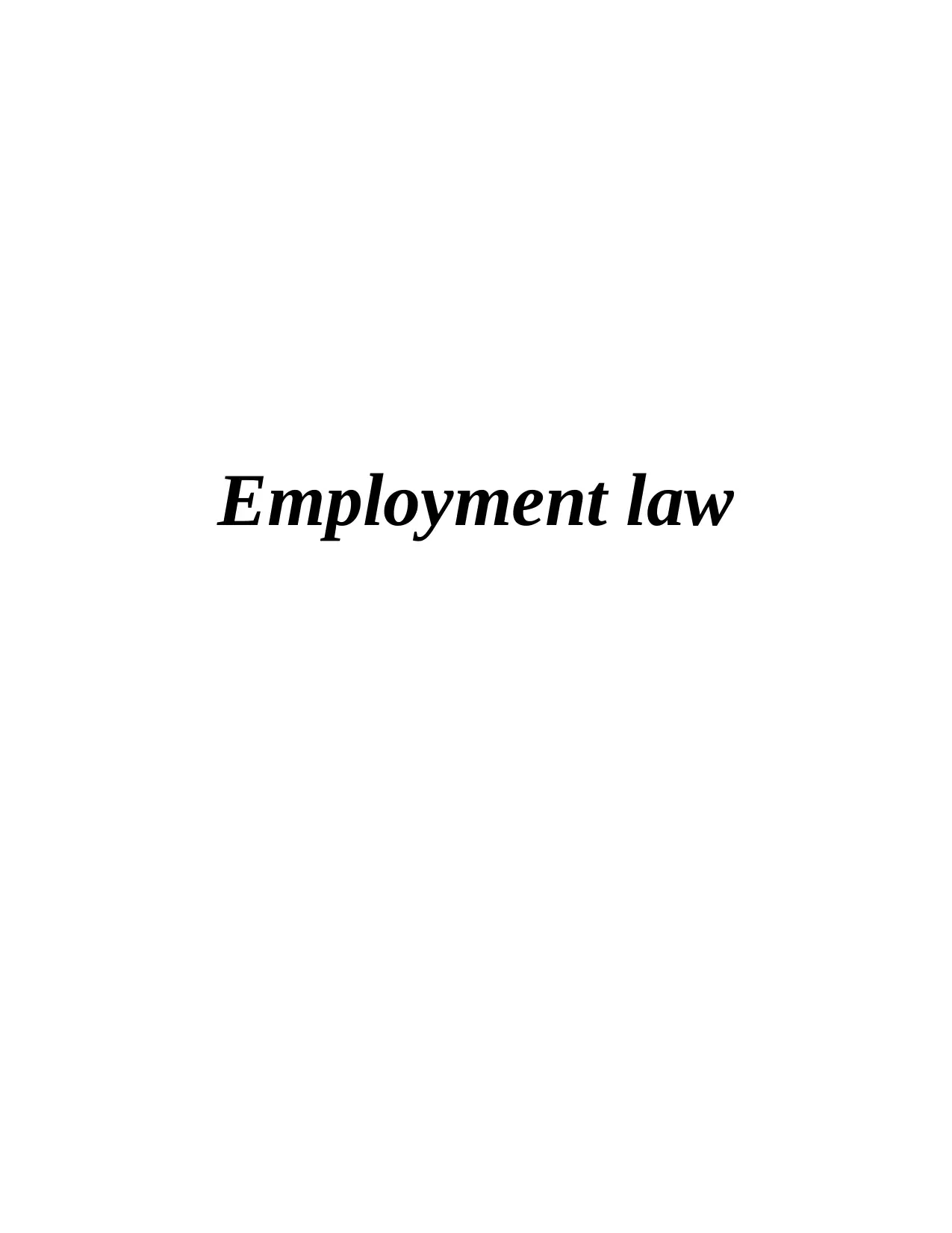
Employment law
Secure Best Marks with AI Grader
Need help grading? Try our AI Grader for instant feedback on your assignments.
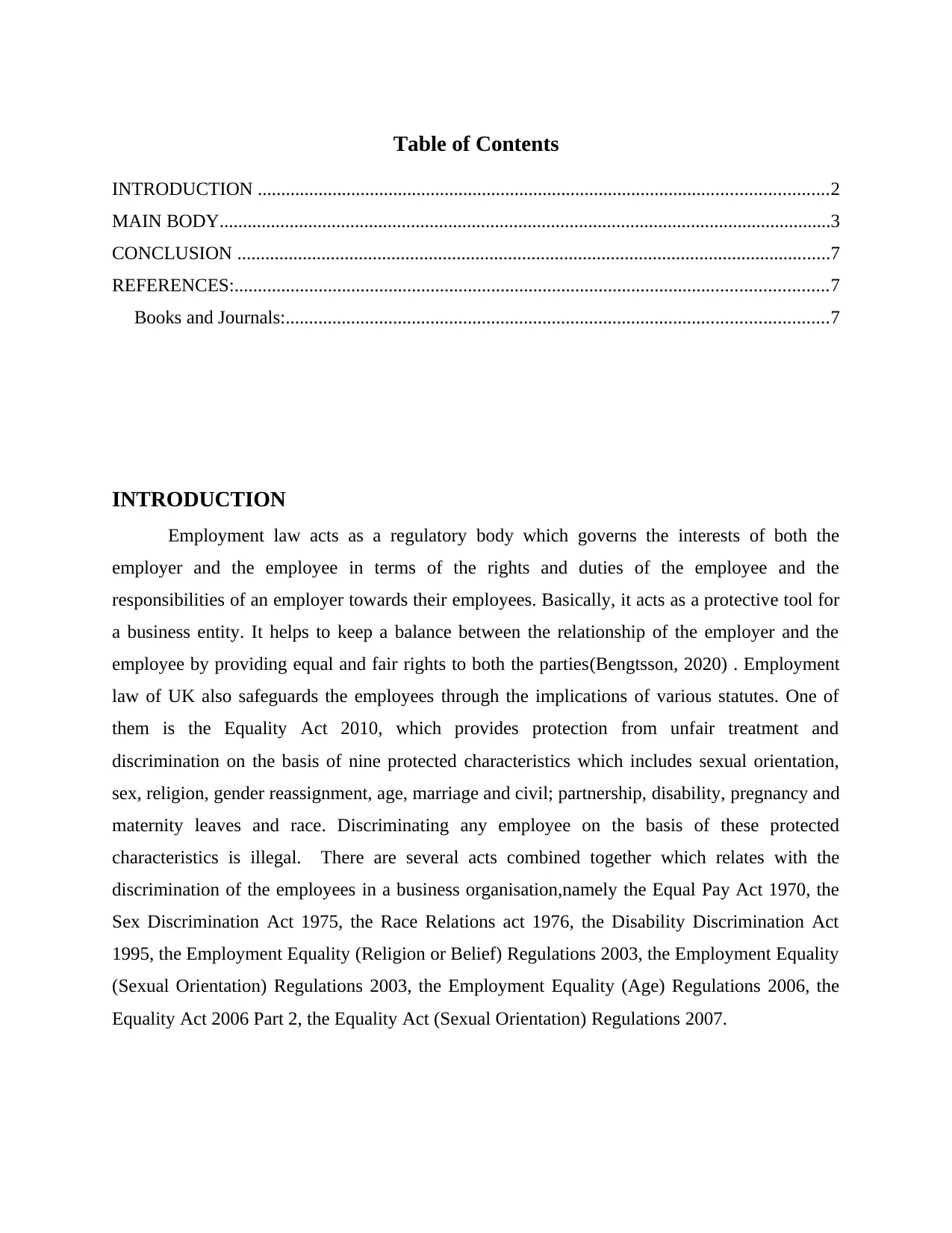
Table of Contents
INTRODUCTION ..........................................................................................................................2
MAIN BODY...................................................................................................................................3
CONCLUSION ...............................................................................................................................7
REFERENCES:...............................................................................................................................7
Books and Journals:....................................................................................................................7
INTRODUCTION
Employment law acts as a regulatory body which governs the interests of both the
employer and the employee in terms of the rights and duties of the employee and the
responsibilities of an employer towards their employees. Basically, it acts as a protective tool for
a business entity. It helps to keep a balance between the relationship of the employer and the
employee by providing equal and fair rights to both the parties(Bengtsson, 2020) . Employment
law of UK also safeguards the employees through the implications of various statutes. One of
them is the Equality Act 2010, which provides protection from unfair treatment and
discrimination on the basis of nine protected characteristics which includes sexual orientation,
sex, religion, gender reassignment, age, marriage and civil; partnership, disability, pregnancy and
maternity leaves and race. Discriminating any employee on the basis of these protected
characteristics is illegal. There are several acts combined together which relates with the
discrimination of the employees in a business organisation,namely the Equal Pay Act 1970, the
Sex Discrimination Act 1975, the Race Relations act 1976, the Disability Discrimination Act
1995, the Employment Equality (Religion or Belief) Regulations 2003, the Employment Equality
(Sexual Orientation) Regulations 2003, the Employment Equality (Age) Regulations 2006, the
Equality Act 2006 Part 2, the Equality Act (Sexual Orientation) Regulations 2007.
INTRODUCTION ..........................................................................................................................2
MAIN BODY...................................................................................................................................3
CONCLUSION ...............................................................................................................................7
REFERENCES:...............................................................................................................................7
Books and Journals:....................................................................................................................7
INTRODUCTION
Employment law acts as a regulatory body which governs the interests of both the
employer and the employee in terms of the rights and duties of the employee and the
responsibilities of an employer towards their employees. Basically, it acts as a protective tool for
a business entity. It helps to keep a balance between the relationship of the employer and the
employee by providing equal and fair rights to both the parties(Bengtsson, 2020) . Employment
law of UK also safeguards the employees through the implications of various statutes. One of
them is the Equality Act 2010, which provides protection from unfair treatment and
discrimination on the basis of nine protected characteristics which includes sexual orientation,
sex, religion, gender reassignment, age, marriage and civil; partnership, disability, pregnancy and
maternity leaves and race. Discriminating any employee on the basis of these protected
characteristics is illegal. There are several acts combined together which relates with the
discrimination of the employees in a business organisation,namely the Equal Pay Act 1970, the
Sex Discrimination Act 1975, the Race Relations act 1976, the Disability Discrimination Act
1995, the Employment Equality (Religion or Belief) Regulations 2003, the Employment Equality
(Sexual Orientation) Regulations 2003, the Employment Equality (Age) Regulations 2006, the
Equality Act 2006 Part 2, the Equality Act (Sexual Orientation) Regulations 2007.
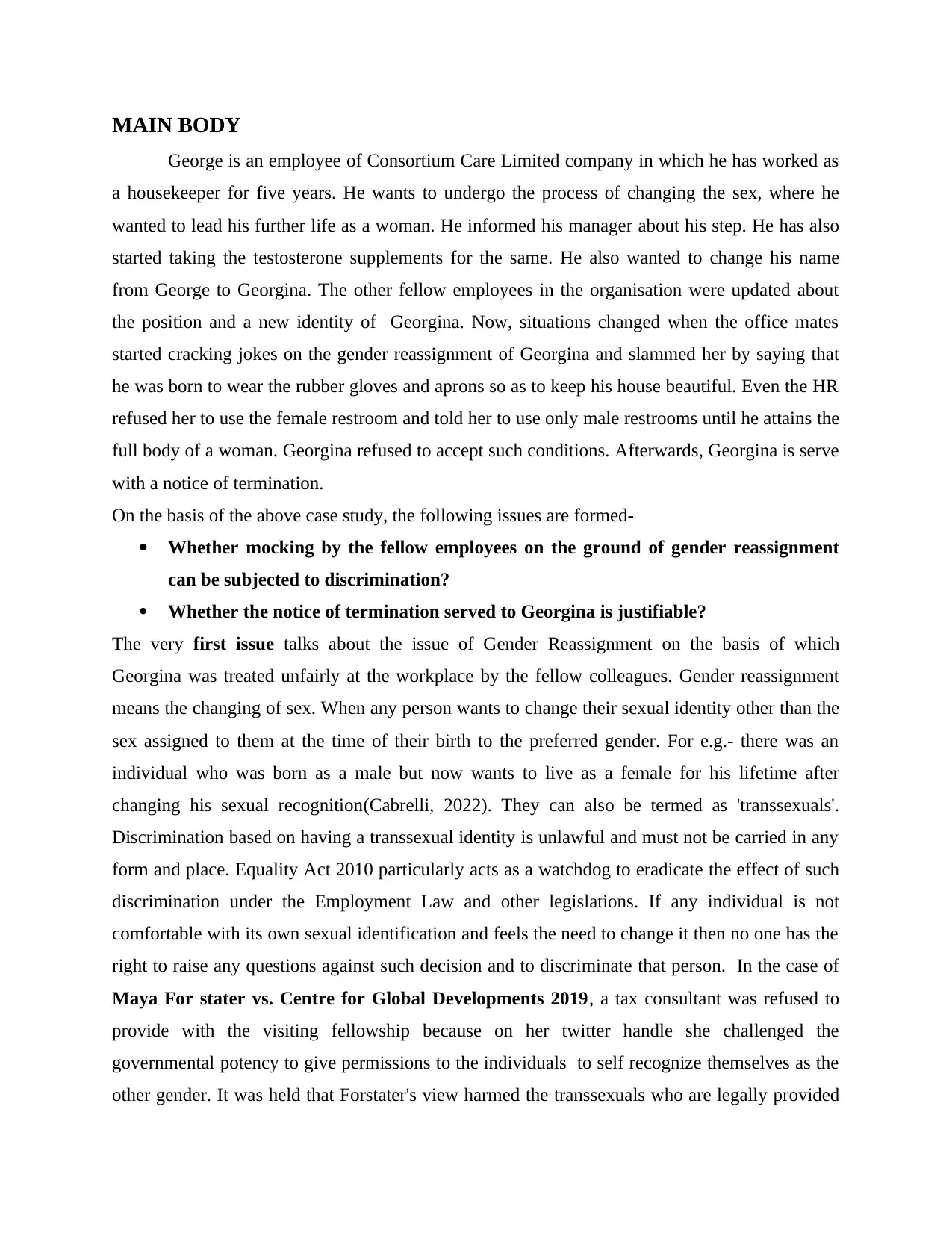
MAIN BODY
George is an employee of Consortium Care Limited company in which he has worked as
a housekeeper for five years. He wants to undergo the process of changing the sex, where he
wanted to lead his further life as a woman. He informed his manager about his step. He has also
started taking the testosterone supplements for the same. He also wanted to change his name
from George to Georgina. The other fellow employees in the organisation were updated about
the position and a new identity of Georgina. Now, situations changed when the office mates
started cracking jokes on the gender reassignment of Georgina and slammed her by saying that
he was born to wear the rubber gloves and aprons so as to keep his house beautiful. Even the HR
refused her to use the female restroom and told her to use only male restrooms until he attains the
full body of a woman. Georgina refused to accept such conditions. Afterwards, Georgina is serve
with a notice of termination.
On the basis of the above case study, the following issues are formed-
Whether mocking by the fellow employees on the ground of gender reassignment
can be subjected to discrimination?
Whether the notice of termination served to Georgina is justifiable?
The very first issue talks about the issue of Gender Reassignment on the basis of which
Georgina was treated unfairly at the workplace by the fellow colleagues. Gender reassignment
means the changing of sex. When any person wants to change their sexual identity other than the
sex assigned to them at the time of their birth to the preferred gender. For e.g.- there was an
individual who was born as a male but now wants to live as a female for his lifetime after
changing his sexual recognition(Cabrelli, 2022). They can also be termed as 'transsexuals'.
Discrimination based on having a transsexual identity is unlawful and must not be carried in any
form and place. Equality Act 2010 particularly acts as a watchdog to eradicate the effect of such
discrimination under the Employment Law and other legislations. If any individual is not
comfortable with its own sexual identification and feels the need to change it then no one has the
right to raise any questions against such decision and to discriminate that person. In the case of
Maya For stater vs. Centre for Global Developments 2019, a tax consultant was refused to
provide with the visiting fellowship because on her twitter handle she challenged the
governmental potency to give permissions to the individuals to self recognize themselves as the
other gender. It was held that Forstater's view harmed the transsexuals who are legally provided
George is an employee of Consortium Care Limited company in which he has worked as
a housekeeper for five years. He wants to undergo the process of changing the sex, where he
wanted to lead his further life as a woman. He informed his manager about his step. He has also
started taking the testosterone supplements for the same. He also wanted to change his name
from George to Georgina. The other fellow employees in the organisation were updated about
the position and a new identity of Georgina. Now, situations changed when the office mates
started cracking jokes on the gender reassignment of Georgina and slammed her by saying that
he was born to wear the rubber gloves and aprons so as to keep his house beautiful. Even the HR
refused her to use the female restroom and told her to use only male restrooms until he attains the
full body of a woman. Georgina refused to accept such conditions. Afterwards, Georgina is serve
with a notice of termination.
On the basis of the above case study, the following issues are formed-
Whether mocking by the fellow employees on the ground of gender reassignment
can be subjected to discrimination?
Whether the notice of termination served to Georgina is justifiable?
The very first issue talks about the issue of Gender Reassignment on the basis of which
Georgina was treated unfairly at the workplace by the fellow colleagues. Gender reassignment
means the changing of sex. When any person wants to change their sexual identity other than the
sex assigned to them at the time of their birth to the preferred gender. For e.g.- there was an
individual who was born as a male but now wants to live as a female for his lifetime after
changing his sexual recognition(Cabrelli, 2022). They can also be termed as 'transsexuals'.
Discrimination based on having a transsexual identity is unlawful and must not be carried in any
form and place. Equality Act 2010 particularly acts as a watchdog to eradicate the effect of such
discrimination under the Employment Law and other legislations. If any individual is not
comfortable with its own sexual identification and feels the need to change it then no one has the
right to raise any questions against such decision and to discriminate that person. In the case of
Maya For stater vs. Centre for Global Developments 2019, a tax consultant was refused to
provide with the visiting fellowship because on her twitter handle she challenged the
governmental potency to give permissions to the individuals to self recognize themselves as the
other gender. It was held that Forstater's view harmed the transsexuals who are legally provided
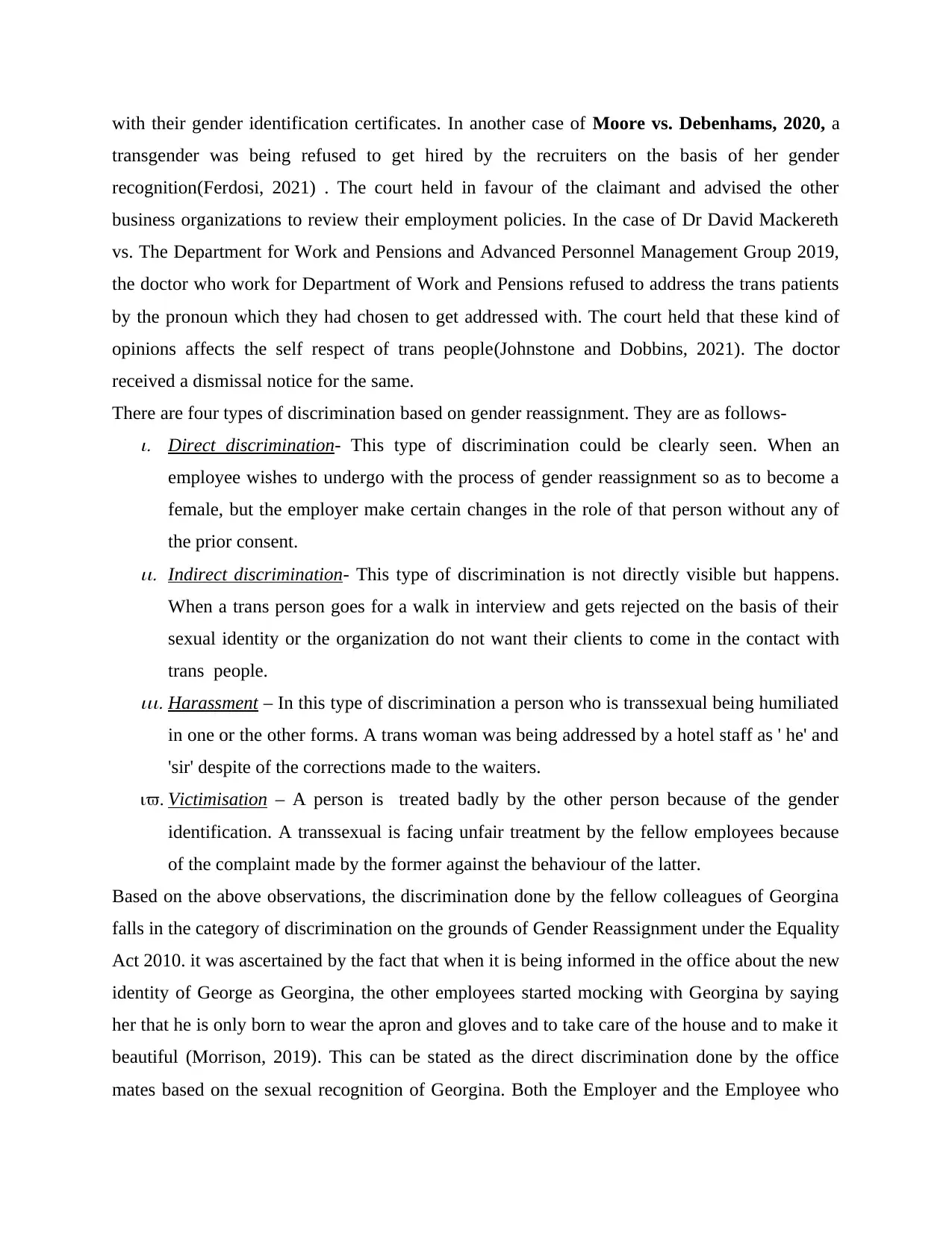
with their gender identification certificates. In another case of Moore vs. Debenhams, 2020, a
transgender was being refused to get hired by the recruiters on the basis of her gender
recognition(Ferdosi, 2021) . The court held in favour of the claimant and advised the other
business organizations to review their employment policies. In the case of Dr David Mackereth
vs. The Department for Work and Pensions and Advanced Personnel Management Group 2019,
the doctor who work for Department of Work and Pensions refused to address the trans patients
by the pronoun which they had chosen to get addressed with. The court held that these kind of
opinions affects the self respect of trans people(Johnstone and Dobbins, 2021). The doctor
received a dismissal notice for the same.
There are four types of discrimination based on gender reassignment. They are as follows-i. Direct discrimination- This type of discrimination could be clearly seen. When an
employee wishes to undergo with the process of gender reassignment so as to become a
female, but the employer make certain changes in the role of that person without any of
the prior consent.ii. Indirect discrimination- This type of discrimination is not directly visible but happens.
When a trans person goes for a walk in interview and gets rejected on the basis of their
sexual identity or the organization do not want their clients to come in the contact with
trans people.iii. Harassment – In this type of discrimination a person who is transsexual being humiliated
in one or the other forms. A trans woman was being addressed by a hotel staff as ' he' and
'sir' despite of the corrections made to the waiters.
iv. Victimisation – A person is treated badly by the other person because of the gender
identification. A transsexual is facing unfair treatment by the fellow employees because
of the complaint made by the former against the behaviour of the latter.
Based on the above observations, the discrimination done by the fellow colleagues of Georgina
falls in the category of discrimination on the grounds of Gender Reassignment under the Equality
Act 2010. it was ascertained by the fact that when it is being informed in the office about the new
identity of George as Georgina, the other employees started mocking with Georgina by saying
her that he is only born to wear the apron and gloves and to take care of the house and to make it
beautiful (Morrison, 2019). This can be stated as the direct discrimination done by the office
mates based on the sexual recognition of Georgina. Both the Employer and the Employee who
transgender was being refused to get hired by the recruiters on the basis of her gender
recognition(Ferdosi, 2021) . The court held in favour of the claimant and advised the other
business organizations to review their employment policies. In the case of Dr David Mackereth
vs. The Department for Work and Pensions and Advanced Personnel Management Group 2019,
the doctor who work for Department of Work and Pensions refused to address the trans patients
by the pronoun which they had chosen to get addressed with. The court held that these kind of
opinions affects the self respect of trans people(Johnstone and Dobbins, 2021). The doctor
received a dismissal notice for the same.
There are four types of discrimination based on gender reassignment. They are as follows-i. Direct discrimination- This type of discrimination could be clearly seen. When an
employee wishes to undergo with the process of gender reassignment so as to become a
female, but the employer make certain changes in the role of that person without any of
the prior consent.ii. Indirect discrimination- This type of discrimination is not directly visible but happens.
When a trans person goes for a walk in interview and gets rejected on the basis of their
sexual identity or the organization do not want their clients to come in the contact with
trans people.iii. Harassment – In this type of discrimination a person who is transsexual being humiliated
in one or the other forms. A trans woman was being addressed by a hotel staff as ' he' and
'sir' despite of the corrections made to the waiters.
iv. Victimisation – A person is treated badly by the other person because of the gender
identification. A transsexual is facing unfair treatment by the fellow employees because
of the complaint made by the former against the behaviour of the latter.
Based on the above observations, the discrimination done by the fellow colleagues of Georgina
falls in the category of discrimination on the grounds of Gender Reassignment under the Equality
Act 2010. it was ascertained by the fact that when it is being informed in the office about the new
identity of George as Georgina, the other employees started mocking with Georgina by saying
her that he is only born to wear the apron and gloves and to take care of the house and to make it
beautiful (Morrison, 2019). This can be stated as the direct discrimination done by the office
mates based on the sexual recognition of Georgina. Both the Employer and the Employee who
Secure Best Marks with AI Grader
Need help grading? Try our AI Grader for instant feedback on your assignments.
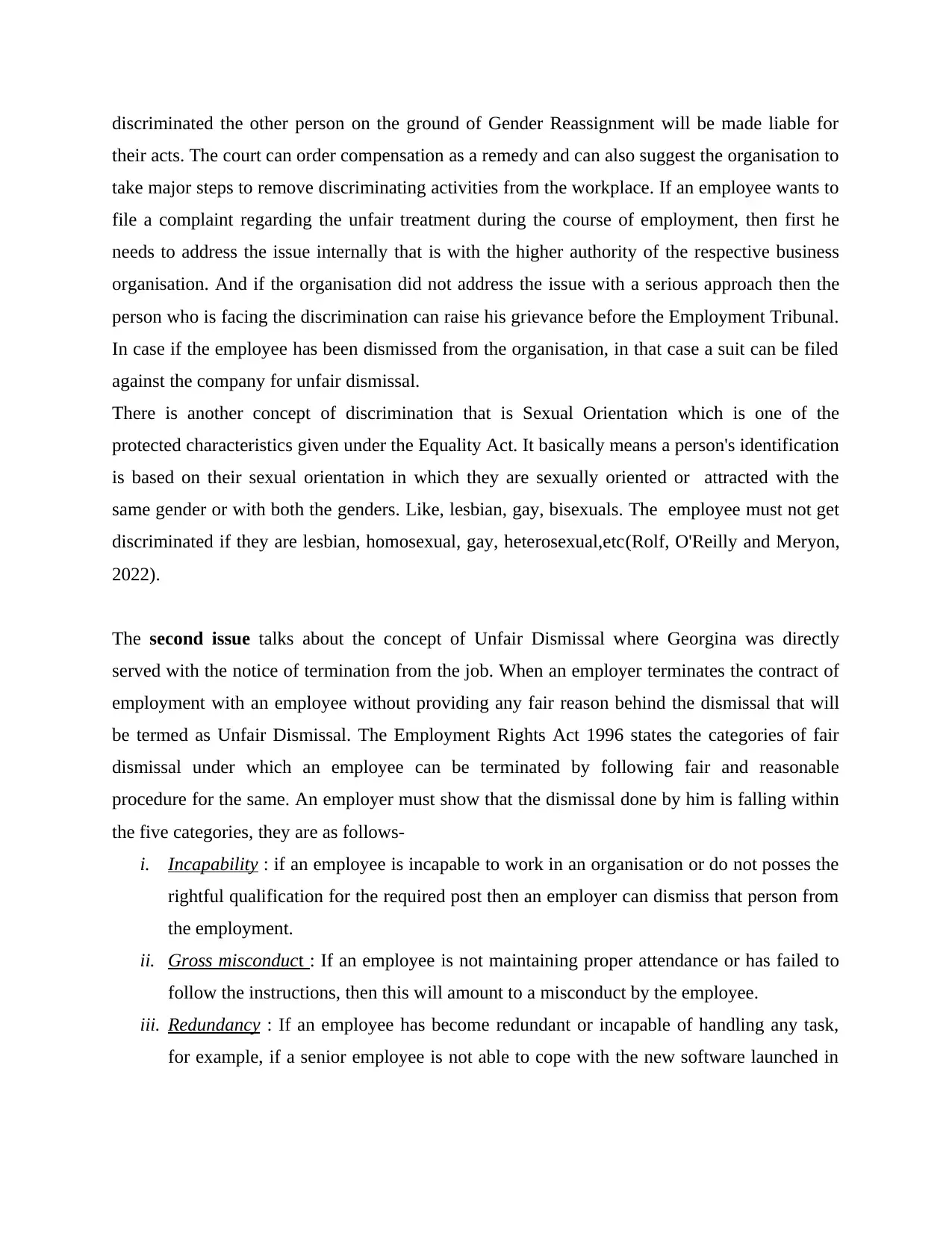
discriminated the other person on the ground of Gender Reassignment will be made liable for
their acts. The court can order compensation as a remedy and can also suggest the organisation to
take major steps to remove discriminating activities from the workplace. If an employee wants to
file a complaint regarding the unfair treatment during the course of employment, then first he
needs to address the issue internally that is with the higher authority of the respective business
organisation. And if the organisation did not address the issue with a serious approach then the
person who is facing the discrimination can raise his grievance before the Employment Tribunal.
In case if the employee has been dismissed from the organisation, in that case a suit can be filed
against the company for unfair dismissal.
There is another concept of discrimination that is Sexual Orientation which is one of the
protected characteristics given under the Equality Act. It basically means a person's identification
is based on their sexual orientation in which they are sexually oriented or attracted with the
same gender or with both the genders. Like, lesbian, gay, bisexuals. The employee must not get
discriminated if they are lesbian, homosexual, gay, heterosexual,etc(Rolf, O'Reilly and Meryon,
2022).
The second issue talks about the concept of Unfair Dismissal where Georgina was directly
served with the notice of termination from the job. When an employer terminates the contract of
employment with an employee without providing any fair reason behind the dismissal that will
be termed as Unfair Dismissal. The Employment Rights Act 1996 states the categories of fair
dismissal under which an employee can be terminated by following fair and reasonable
procedure for the same. An employer must show that the dismissal done by him is falling within
the five categories, they are as follows-
i. Incapability : if an employee is incapable to work in an organisation or do not posses the
rightful qualification for the required post then an employer can dismiss that person from
the employment.
ii. Gross misconduct : If an employee is not maintaining proper attendance or has failed to
follow the instructions, then this will amount to a misconduct by the employee.
iii. Redundancy : If an employee has become redundant or incapable of handling any task,
for example, if a senior employee is not able to cope with the new software launched in
their acts. The court can order compensation as a remedy and can also suggest the organisation to
take major steps to remove discriminating activities from the workplace. If an employee wants to
file a complaint regarding the unfair treatment during the course of employment, then first he
needs to address the issue internally that is with the higher authority of the respective business
organisation. And if the organisation did not address the issue with a serious approach then the
person who is facing the discrimination can raise his grievance before the Employment Tribunal.
In case if the employee has been dismissed from the organisation, in that case a suit can be filed
against the company for unfair dismissal.
There is another concept of discrimination that is Sexual Orientation which is one of the
protected characteristics given under the Equality Act. It basically means a person's identification
is based on their sexual orientation in which they are sexually oriented or attracted with the
same gender or with both the genders. Like, lesbian, gay, bisexuals. The employee must not get
discriminated if they are lesbian, homosexual, gay, heterosexual,etc(Rolf, O'Reilly and Meryon,
2022).
The second issue talks about the concept of Unfair Dismissal where Georgina was directly
served with the notice of termination from the job. When an employer terminates the contract of
employment with an employee without providing any fair reason behind the dismissal that will
be termed as Unfair Dismissal. The Employment Rights Act 1996 states the categories of fair
dismissal under which an employee can be terminated by following fair and reasonable
procedure for the same. An employer must show that the dismissal done by him is falling within
the five categories, they are as follows-
i. Incapability : if an employee is incapable to work in an organisation or do not posses the
rightful qualification for the required post then an employer can dismiss that person from
the employment.
ii. Gross misconduct : If an employee is not maintaining proper attendance or has failed to
follow the instructions, then this will amount to a misconduct by the employee.
iii. Redundancy : If an employee has become redundant or incapable of handling any task,
for example, if a senior employee is not able to cope with the new software launched in
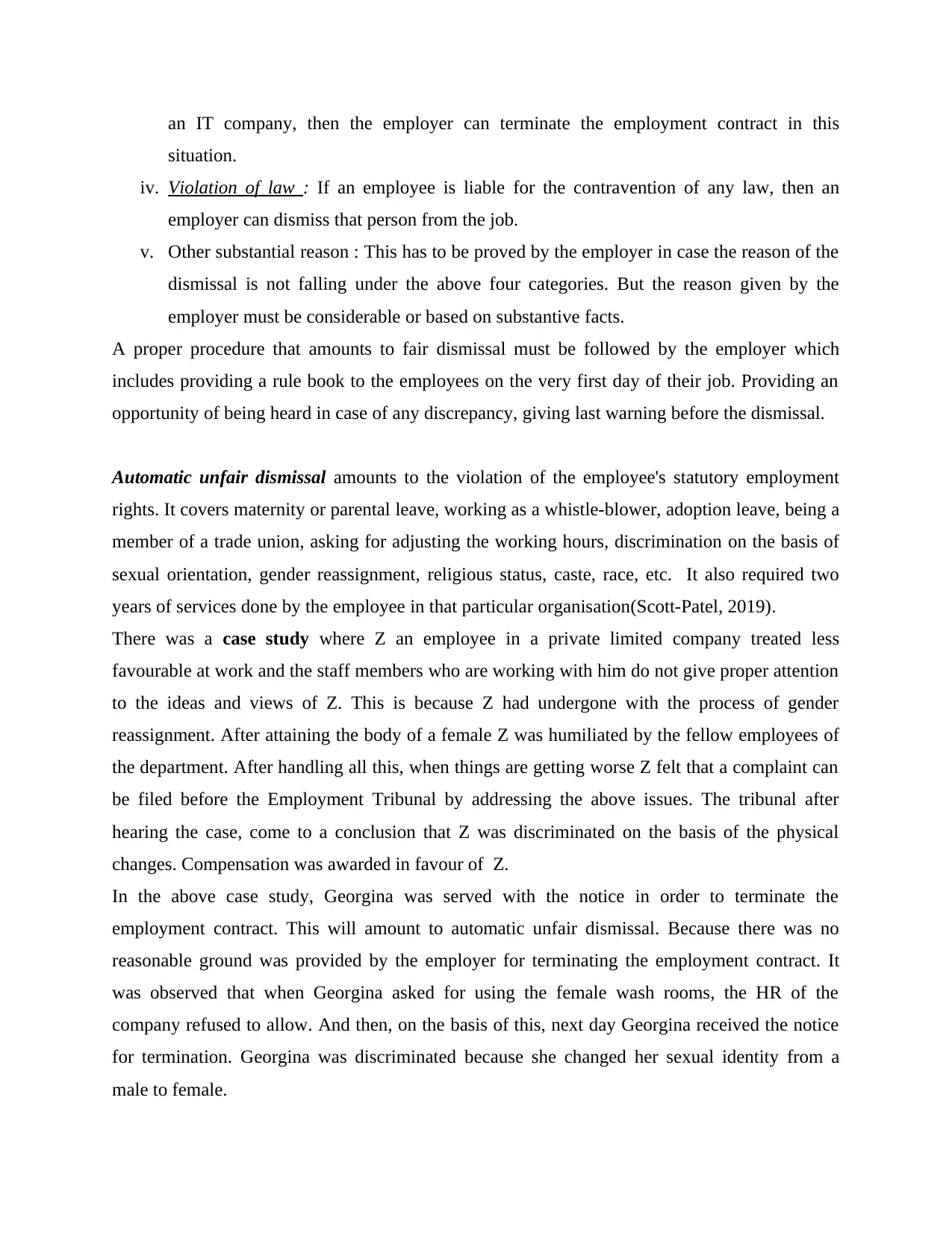
an IT company, then the employer can terminate the employment contract in this
situation.
iv. Violation of law : If an employee is liable for the contravention of any law, then an
employer can dismiss that person from the job.
v. Other substantial reason : This has to be proved by the employer in case the reason of the
dismissal is not falling under the above four categories. But the reason given by the
employer must be considerable or based on substantive facts.
A proper procedure that amounts to fair dismissal must be followed by the employer which
includes providing a rule book to the employees on the very first day of their job. Providing an
opportunity of being heard in case of any discrepancy, giving last warning before the dismissal.
Automatic unfair dismissal amounts to the violation of the employee's statutory employment
rights. It covers maternity or parental leave, working as a whistle-blower, adoption leave, being a
member of a trade union, asking for adjusting the working hours, discrimination on the basis of
sexual orientation, gender reassignment, religious status, caste, race, etc. It also required two
years of services done by the employee in that particular organisation(Scott-Patel, 2019).
There was a case study where Z an employee in a private limited company treated less
favourable at work and the staff members who are working with him do not give proper attention
to the ideas and views of Z. This is because Z had undergone with the process of gender
reassignment. After attaining the body of a female Z was humiliated by the fellow employees of
the department. After handling all this, when things are getting worse Z felt that a complaint can
be filed before the Employment Tribunal by addressing the above issues. The tribunal after
hearing the case, come to a conclusion that Z was discriminated on the basis of the physical
changes. Compensation was awarded in favour of Z.
In the above case study, Georgina was served with the notice in order to terminate the
employment contract. This will amount to automatic unfair dismissal. Because there was no
reasonable ground was provided by the employer for terminating the employment contract. It
was observed that when Georgina asked for using the female wash rooms, the HR of the
company refused to allow. And then, on the basis of this, next day Georgina received the notice
for termination. Georgina was discriminated because she changed her sexual identity from a
male to female.
situation.
iv. Violation of law : If an employee is liable for the contravention of any law, then an
employer can dismiss that person from the job.
v. Other substantial reason : This has to be proved by the employer in case the reason of the
dismissal is not falling under the above four categories. But the reason given by the
employer must be considerable or based on substantive facts.
A proper procedure that amounts to fair dismissal must be followed by the employer which
includes providing a rule book to the employees on the very first day of their job. Providing an
opportunity of being heard in case of any discrepancy, giving last warning before the dismissal.
Automatic unfair dismissal amounts to the violation of the employee's statutory employment
rights. It covers maternity or parental leave, working as a whistle-blower, adoption leave, being a
member of a trade union, asking for adjusting the working hours, discrimination on the basis of
sexual orientation, gender reassignment, religious status, caste, race, etc. It also required two
years of services done by the employee in that particular organisation(Scott-Patel, 2019).
There was a case study where Z an employee in a private limited company treated less
favourable at work and the staff members who are working with him do not give proper attention
to the ideas and views of Z. This is because Z had undergone with the process of gender
reassignment. After attaining the body of a female Z was humiliated by the fellow employees of
the department. After handling all this, when things are getting worse Z felt that a complaint can
be filed before the Employment Tribunal by addressing the above issues. The tribunal after
hearing the case, come to a conclusion that Z was discriminated on the basis of the physical
changes. Compensation was awarded in favour of Z.
In the above case study, Georgina was served with the notice in order to terminate the
employment contract. This will amount to automatic unfair dismissal. Because there was no
reasonable ground was provided by the employer for terminating the employment contract. It
was observed that when Georgina asked for using the female wash rooms, the HR of the
company refused to allow. And then, on the basis of this, next day Georgina received the notice
for termination. Georgina was discriminated because she changed her sexual identity from a
male to female.
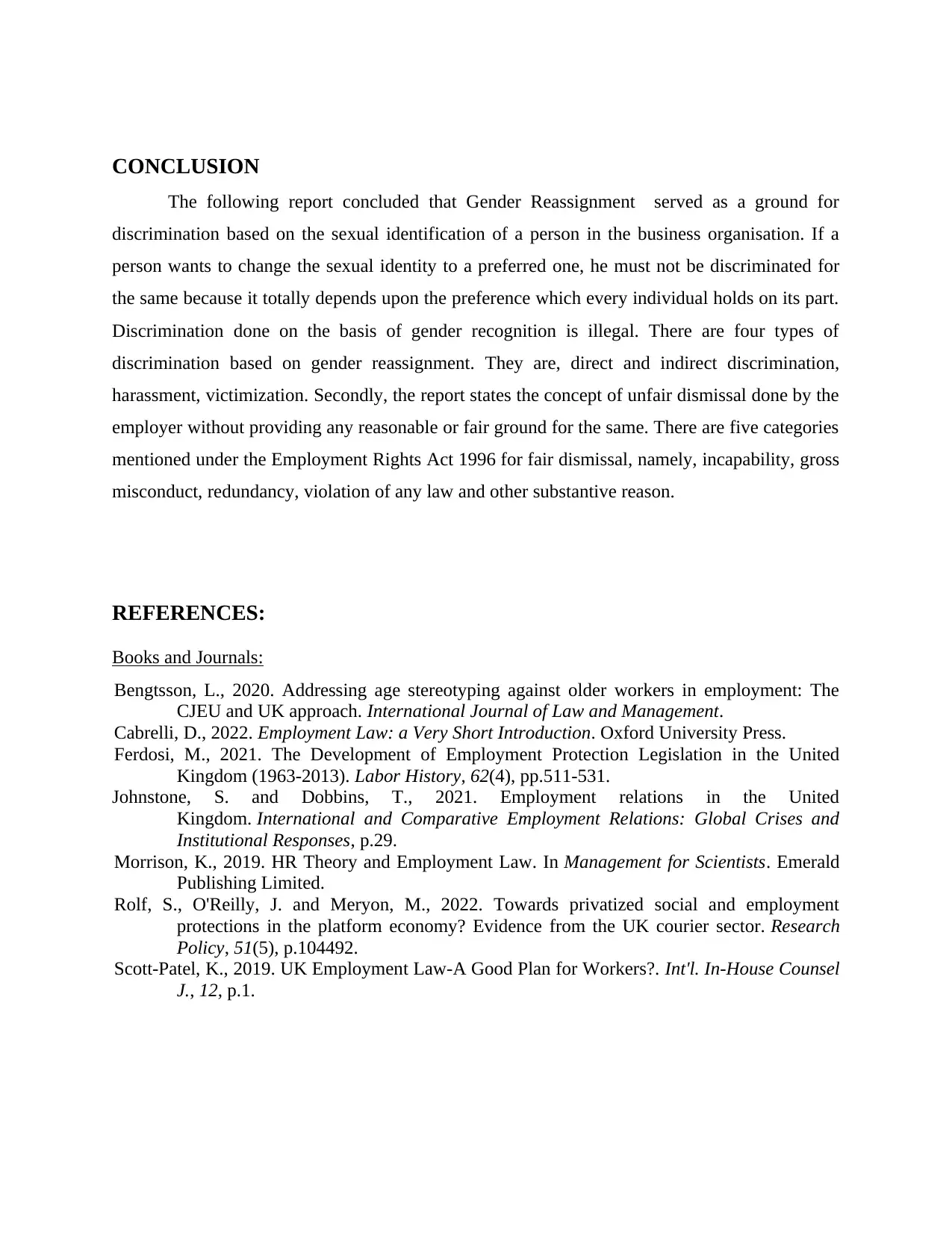
CONCLUSION
The following report concluded that Gender Reassignment served as a ground for
discrimination based on the sexual identification of a person in the business organisation. If a
person wants to change the sexual identity to a preferred one, he must not be discriminated for
the same because it totally depends upon the preference which every individual holds on its part.
Discrimination done on the basis of gender recognition is illegal. There are four types of
discrimination based on gender reassignment. They are, direct and indirect discrimination,
harassment, victimization. Secondly, the report states the concept of unfair dismissal done by the
employer without providing any reasonable or fair ground for the same. There are five categories
mentioned under the Employment Rights Act 1996 for fair dismissal, namely, incapability, gross
misconduct, redundancy, violation of any law and other substantive reason.
REFERENCES:
Books and Journals:
Bengtsson, L., 2020. Addressing age stereotyping against older workers in employment: The
CJEU and UK approach. International Journal of Law and Management.
Cabrelli, D., 2022. Employment Law: a Very Short Introduction. Oxford University Press.
Ferdosi, M., 2021. The Development of Employment Protection Legislation in the United
Kingdom (1963-2013). Labor History, 62(4), pp.511-531.
Johnstone, S. and Dobbins, T., 2021. Employment relations in the United
Kingdom. International and Comparative Employment Relations: Global Crises and
Institutional Responses, p.29.
Morrison, K., 2019. HR Theory and Employment Law. In Management for Scientists. Emerald
Publishing Limited.
Rolf, S., O'Reilly, J. and Meryon, M., 2022. Towards privatized social and employment
protections in the platform economy? Evidence from the UK courier sector. Research
Policy, 51(5), p.104492.
Scott-Patel, K., 2019. UK Employment Law-A Good Plan for Workers?. Int'l. In-House Counsel
J., 12, p.1.
The following report concluded that Gender Reassignment served as a ground for
discrimination based on the sexual identification of a person in the business organisation. If a
person wants to change the sexual identity to a preferred one, he must not be discriminated for
the same because it totally depends upon the preference which every individual holds on its part.
Discrimination done on the basis of gender recognition is illegal. There are four types of
discrimination based on gender reassignment. They are, direct and indirect discrimination,
harassment, victimization. Secondly, the report states the concept of unfair dismissal done by the
employer without providing any reasonable or fair ground for the same. There are five categories
mentioned under the Employment Rights Act 1996 for fair dismissal, namely, incapability, gross
misconduct, redundancy, violation of any law and other substantive reason.
REFERENCES:
Books and Journals:
Bengtsson, L., 2020. Addressing age stereotyping against older workers in employment: The
CJEU and UK approach. International Journal of Law and Management.
Cabrelli, D., 2022. Employment Law: a Very Short Introduction. Oxford University Press.
Ferdosi, M., 2021. The Development of Employment Protection Legislation in the United
Kingdom (1963-2013). Labor History, 62(4), pp.511-531.
Johnstone, S. and Dobbins, T., 2021. Employment relations in the United
Kingdom. International and Comparative Employment Relations: Global Crises and
Institutional Responses, p.29.
Morrison, K., 2019. HR Theory and Employment Law. In Management for Scientists. Emerald
Publishing Limited.
Rolf, S., O'Reilly, J. and Meryon, M., 2022. Towards privatized social and employment
protections in the platform economy? Evidence from the UK courier sector. Research
Policy, 51(5), p.104492.
Scott-Patel, K., 2019. UK Employment Law-A Good Plan for Workers?. Int'l. In-House Counsel
J., 12, p.1.
1 out of 7
Related Documents
Your All-in-One AI-Powered Toolkit for Academic Success.
+13062052269
info@desklib.com
Available 24*7 on WhatsApp / Email
![[object Object]](/_next/static/media/star-bottom.7253800d.svg)
Unlock your academic potential
© 2024 | Zucol Services PVT LTD | All rights reserved.





